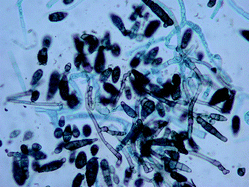Fungal spores from Pleosporales in the atmosphere of urban and rural locations in Portugal
Abstract

* Corresponding authors
a
Environment, Society and Education Group, Geology Centre, University of Porto & Biology Department, Faculty of Sciences, University of Porto, Edifício FC4, Rua do Campo Alegre, s/n, 4169-007 Porto, Portugal
E-mail:
ianoronh@fc.up.pt
Fax: +351 226 099 157
Tel: +351 226 074 918
b Service and Laboratory of Immunology & Faculty of Medicine, University of Porto, Portugal

 Please wait while we load your content...
Something went wrong. Try again?
Please wait while we load your content...
Something went wrong. Try again?
M. Oliveira, L. Delgado, H. Ribeiro and I. Abreu, J. Environ. Monit., 2010, 12, 1187 DOI: 10.1039/B913705J
To request permission to reproduce material from this article, please go to the Copyright Clearance Center request page.
If you are an author contributing to an RSC publication, you do not need to request permission provided correct acknowledgement is given.
If you are the author of this article, you do not need to request permission to reproduce figures and diagrams provided correct acknowledgement is given. If you want to reproduce the whole article in a third-party publication (excluding your thesis/dissertation for which permission is not required) please go to the Copyright Clearance Center request page.
Read more about how to correctly acknowledge RSC content.
 Fetching data from CrossRef.
Fetching data from CrossRef.
This may take some time to load.
Loading related content
